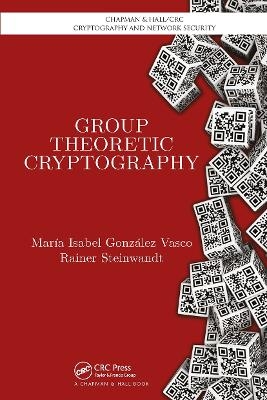
Group Theoretic Cryptography
Seiten
2024
Chapman & Hall/CRC (Verlag)
978-1-032-92550-9 (ISBN)
Chapman & Hall/CRC (Verlag)
978-1-032-92550-9 (ISBN)
Group theory appears to be a promising source of hard computational problems for deploying new cryptographic constructions. This reference focuses on the specifics of using groups, including in particular non-Abelian groups, in the field of cryptography. It provides an introduction to cryptography with emphasis on the group theoretic perspective
Group theoretic problems have propelled scientific achievements across a wide range of fields, including mathematics, physics, chemistry, and the life sciences. Many cryptographic constructions exploit the computational hardness of group theoretical problems, and the area is viewed as a potential source of quantum-resilient cryptographic primitives for the future.
Group Theoretic Cryptography supplies an ideal introduction to cryptography for those who are interested in group theory and want to learn about the possible interplays between the two fields. Assuming an undergraduate-level understanding of linear algebra and discrete mathematics, it details the specifics of using non-Abelian groups in the field of cryptography.
Moreover, the book evidences how group theoretic techniques help us gain new insight into well known, seemingly unrelated, cryptographic constructions, such as DES.
The book starts with brief overviews of the fundamentals of group theory, complexity theory, and cryptography. Part two is devoted to public-key encryption, including provable security guarantees, public-key encryption in the standard model, and public-key encryption using infinite groups.
The third part of the book covers secret-key encryption. It examines block ciphers, like the Advanced Encryption Standard, and cryptographic hash functions and message authentication codes. The last part delves into a number of cryptographic applications which are nowadays as relevant as encryption—identification protocols, key establishment, and signature schemes are covered.
The book supplies formal security analyses and highlights potential vulnerabilities for cryptographic constructions involving group theory. Summaries and references for further reading, as well as exercises, are included at the end of each chapter. Selected solutions for exercises are provided in the back of the book.
Group theoretic problems have propelled scientific achievements across a wide range of fields, including mathematics, physics, chemistry, and the life sciences. Many cryptographic constructions exploit the computational hardness of group theoretical problems, and the area is viewed as a potential source of quantum-resilient cryptographic primitives for the future.
Group Theoretic Cryptography supplies an ideal introduction to cryptography for those who are interested in group theory and want to learn about the possible interplays between the two fields. Assuming an undergraduate-level understanding of linear algebra and discrete mathematics, it details the specifics of using non-Abelian groups in the field of cryptography.
Moreover, the book evidences how group theoretic techniques help us gain new insight into well known, seemingly unrelated, cryptographic constructions, such as DES.
The book starts with brief overviews of the fundamentals of group theory, complexity theory, and cryptography. Part two is devoted to public-key encryption, including provable security guarantees, public-key encryption in the standard model, and public-key encryption using infinite groups.
The third part of the book covers secret-key encryption. It examines block ciphers, like the Advanced Encryption Standard, and cryptographic hash functions and message authentication codes. The last part delves into a number of cryptographic applications which are nowadays as relevant as encryption—identification protocols, key establishment, and signature schemes are covered.
The book supplies formal security analyses and highlights potential vulnerabilities for cryptographic constructions involving group theory. Summaries and references for further reading, as well as exercises, are included at the end of each chapter. Selected solutions for exercises are provided in the back of the book.
Maria Isabel Gonzalez Vasco, Rainer Steinwandt
Preliminaries. Public-Key Encryption. Secret-Key Encryption. Other Cryptographic Constructions. Appendix.
| Erscheinungsdatum | 16.10.2024 |
|---|---|
| Reihe/Serie | Chapman & Hall/CRC Cryptography and Network Security Series |
| Zusatzinfo | 53 Illustrations, black and white |
| Sprache | englisch |
| Maße | 156 x 234 mm |
| Gewicht | 458 g |
| Themenwelt | Mathematik / Informatik ► Mathematik ► Graphentheorie |
| Mathematik / Informatik ► Mathematik ► Logik / Mengenlehre | |
| ISBN-10 | 1-032-92550-7 / 1032925507 |
| ISBN-13 | 978-1-032-92550-9 / 9781032925509 |
| Zustand | Neuware |
| Haben Sie eine Frage zum Produkt? |
Mehr entdecken
aus dem Bereich
aus dem Bereich
Numbers and Counting, Groups, Graphs, Orders and Lattices
Buch | Softcover (2023)
De Gruyter (Verlag)
CHF 89,95
